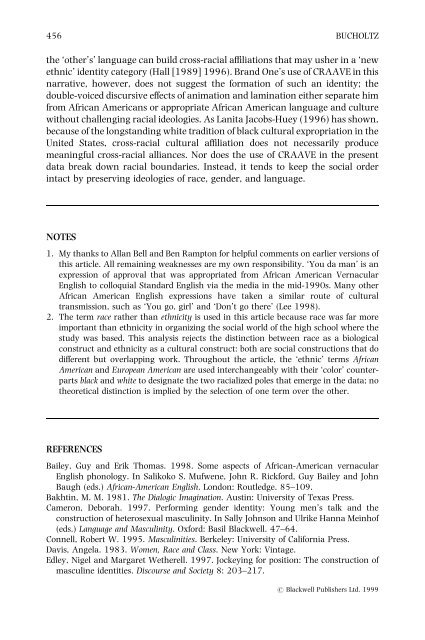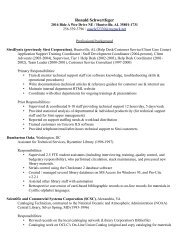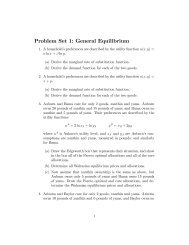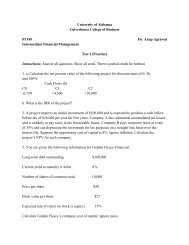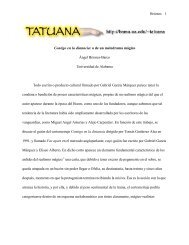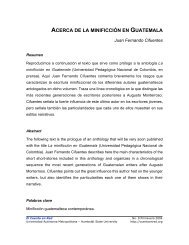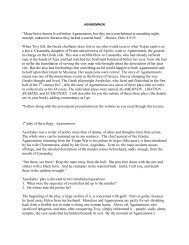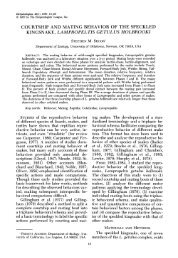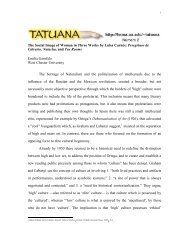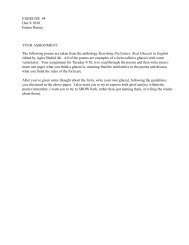You da man: Narrating the racial other in the ... - Bama.Ua.Edu
You da man: Narrating the racial other in the ... - Bama.Ua.Edu
You da man: Narrating the racial other in the ... - Bama.Ua.Edu
You also want an ePaper? Increase the reach of your titles
YUMPU automatically turns print PDFs into web optimized ePapers that Google loves.
456<br />
<strong>the</strong> `o<strong>the</strong>r's' language can build cross-<strong>racial</strong> a liations that may usher <strong>in</strong> a `new<br />
ethnic' identity category (Hall [1989] 1996). Brand One's use of CRAAVE <strong>in</strong> this<br />
narrative, however, does not suggest <strong>the</strong> formation of such an identity; <strong>the</strong><br />
double-voiced discursive e€ects of animation and lam<strong>in</strong>ation ei<strong>the</strong>r separate him<br />
from African Americans or appropriate African American language and culture<br />
without challeng<strong>in</strong>g <strong>racial</strong> ideologies. As Lanita Jacobs-Huey (1996) has shown,<br />
because of <strong>the</strong> longstand<strong>in</strong>g white tradition of black cultural expropriation <strong>in</strong> <strong>the</strong><br />
United States, cross-<strong>racial</strong> cultural a liation does not necessarily produce<br />
mean<strong>in</strong>gful cross-<strong>racial</strong> alliances. Nor does <strong>the</strong> use of CRAAVE <strong>in</strong> <strong>the</strong> present<br />
<strong>da</strong>ta break down <strong>racial</strong> boun<strong>da</strong>ries. Instead, it tends to keep <strong>the</strong> social order<br />
<strong>in</strong>tact by preserv<strong>in</strong>g ideologies of race, gender, and language.<br />
NOTES<br />
1. My thanks to Allan Bell and Ben Rampton for helpful comments on earlier versions of<br />
this article. All rema<strong>in</strong><strong>in</strong>g weaknesses are my own responsibility. `<strong>You</strong> <strong>da</strong> <strong>man</strong>' is an<br />
expression of approval that was appropriated from African American Vernacular<br />
English to colloquial Stan<strong>da</strong>rd English via <strong>the</strong> media <strong>in</strong> <strong>the</strong> mid-1990s. Many o<strong>the</strong>r<br />
African American English expressions have taken a similar route of cultural<br />
transmission, such as `<strong>You</strong> go, girl' and `Don't go <strong>the</strong>re' (Lee 1998).<br />
2. The term race ra<strong>the</strong>r than ethnicity is used <strong>in</strong> this article because race was far more<br />
important than ethnicity <strong>in</strong> organiz<strong>in</strong>g <strong>the</strong> social world of <strong>the</strong> high school where <strong>the</strong><br />
study was based. This analysis rejects <strong>the</strong> dist<strong>in</strong>ction between race as a biological<br />
construct and ethnicity as a cultural construct: both are social constructions that do<br />
di€erent but overlapp<strong>in</strong>g work. Throughout <strong>the</strong> article, <strong>the</strong> `ethnic' terms African<br />
American and European American are used <strong>in</strong>terchangeably with <strong>the</strong>ir `color' counterparts<br />
black and white to designate <strong>the</strong> two <strong>racial</strong>ized poles that emerge <strong>in</strong> <strong>the</strong> <strong>da</strong>ta; no<br />
<strong>the</strong>oretical dist<strong>in</strong>ction is implied by <strong>the</strong> selection of one term over <strong>the</strong> o<strong>the</strong>r.<br />
REFERENCES<br />
BUCHOLTZ<br />
Bailey, Guy and Erik Thomas. 1998. Some aspects of African-American vernacular<br />
English phonology. In Salikoko S. Mufwene, John R. Rickford, Guy Bailey and John<br />
Baugh (eds.) African-American English. London: Routledge. 85±109.<br />
Bakht<strong>in</strong>, M. M. 1981. The Dialogic Imag<strong>in</strong>ation. Aust<strong>in</strong>: University of Texas Press.<br />
Cameron, Deborah. 1997. Perform<strong>in</strong>g gender identity: <strong>You</strong>ng men's talk and <strong>the</strong><br />
construction of heterosexual mascul<strong>in</strong>ity. In Sally Johnson and Ulrike Hanna Me<strong>in</strong>hof<br />
(eds.) Language and Mascul<strong>in</strong>ity. Oxford: Basil Blackwell. 47±64.<br />
Connell, Robert W. 1995. Mascul<strong>in</strong>ities. Berkeley: University of California Press.<br />
Davis, Angela. 1983. Women, Race and Class. New York: V<strong>in</strong>tage.<br />
Edley, Nigel and Margaret We<strong>the</strong>rell. 1997. Jockey<strong>in</strong>g for position: The construction of<br />
mascul<strong>in</strong>e identities. Discourse and Society 8: 203±217.<br />
# Blackwell Publishers Ltd. 1999


